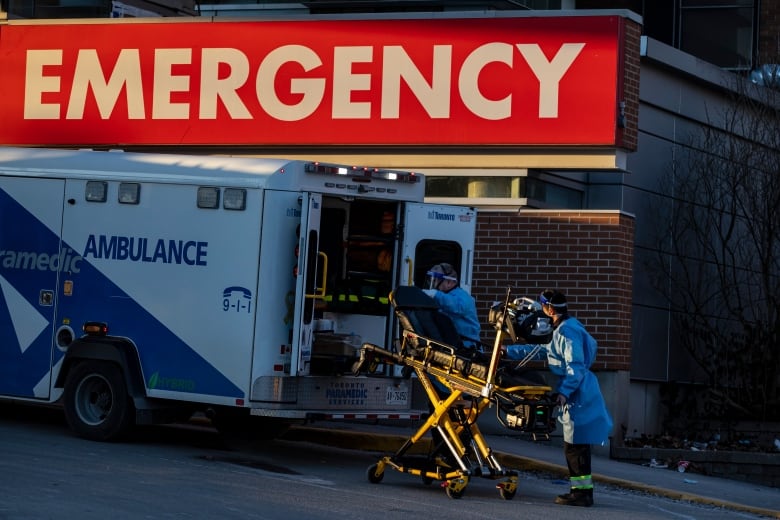These experts say there are solutions to Ontario's huge health-care backlog that go outside the norm
'A lot of what we do in health care isnt efficient,' says surgeon who wants culture shift

Health-care experts say there are solutions to Ontario's immense backlog of non-COVID-19cases, but it would require a "complete rethink" of how the province's health system operates.
The call for a better wayto address the burgeoning crisis comes as non-urgent surgeries resume this week and the province stages talkswith the Ontario Nurses Association to address the crushing shortage of nurses.
The staffing shortage, along with the hugebacklog of cases, were both problems before the pandemic, but the unrelenting chokeholdofCOVID-19on the system has stretchedits threadbare resourceslike never before.
The true size and scopeof the current backlog isn'tknown, but an estimate by the Ontario Medical Association (OMA)puts it at20milliondelayed doctor visits, surgeries and diagnostic tests duringthe pandemic, as of December.
Cure will be anything but quick and painless
Experts say the problems will likely have a profound effect on the health-care system for years to come. The OMA believes tens of thousands of cancers have gone undiagnosed and catching up on knee replacements alone will take 2 years.
It's why some of Ontario's top doctors are calling for a different approach to health care, with some saying fixing the system will likely be anything but quick and painless.
"It's not simply good enough anymore to say doctors should be working longer hours," said Dr. Adam Kassam,president of the OMA and a Toronto physiatrist.
The OMA has released afive-point plan for improving the health system. The main thrust is giving health care more resources, but also linking community and home caredigitally with hospitals while simultaneously expanding how they work with providers in the wider community.
"This requires a complete rethink of how we are designing our health-care system writ large," he said. "What we want to have right now is a collaborative effort for the future so that future generations can rely dependably on the health-care system."
Kassam said that collaborative effortincludes creating regional referral lists, working more closely with family doctorsand building more capacity in community careso patients aren't taking up hospital beds longer than they need to.
'A simple fix'not so simple on the ground
"It's a simple fix in terms of what needs to be done, but not so simple on the ground," said Dr. Shaf Keshavjee,surgeon in chief at Toronto's University Health Network (UHN) and director of the Toronto Lung Transplant Program..

Keshavjee said that, for Ontario's 147 hospitals to become more efficient, they need to improve the way they work together by changingtheir professional culture, something thatinvolves fighting against"the way we've always done it."
"It is our responsibility to figure out how to do things more efficiently and a lot of what we do in health care isn't efficient."
He noted thatUHN has improved its own efficiency by creating a more granular approach to triage, and keeping real-time data so the hospital knows exactly what needs to be done and when.
"The systems we put in place prepared us for the pandemic and will prepare us for the recovery."
The systemshe's referring to is an operational streamlining philosophy called surgical smoothing. Itinvolves separating random, unpredictable surgery cases such as gunshot wounds and broken bones from the predictable ones such as knee or hipreplacements, soemergencies never interrupt a scheduled operation.
Keshavjee saidit meant having five operating rooms, each one with a full staff, on standby for emergencies only.
"It sounds wasteful, but when we did that, those standby rooms were filled 80 per cent of the time."

The hospital increased the speed at which scheduled surgeries were completed by about 10 per cent, and it no longer had to send patients home who were already prepped for surgery because something more urgent came through the doors.
"We basically moved our cancellation rate, or resource shortage rate, to zero with the same number of beds.You don't bump a case, you just keep the train going," Keshavjeesaid.
The system has proven so successful, the hospitalwas able to clear about a third of its backlog before the Omicron wave hit.Keshavjee said that, with further innovation, the hospital has its sights on an ambitious target.
"We do 25,000 operations a year.I think we can do 50,000," he said. "We need to build that kind of capacity to grow surgery, and serve more people and get rid of wait lists."
Still, while getting rid of wait lists is the ideal, it's a long way off. Hospitals remain dangerously overstretched under the burden of the current Omicron wave, and while the health-care community needs to get better at working together, it's hard to do so as a team when you don't have enough people to begin with.
Doctor says 'biggest fear' not having enough workers
"My biggest fear isn't the insurmountable;it's not having enough people to do the work," said Dr. Adam Dukelow, who leads a team of administrators and clinicians to ensure London Health Sciences Centre (LHSC), the largest hospital network in southwestern Ontario, runs at optimal capacity.
Dukelow couldn't give an exact number on the amount of health-care workers thehospital needs, but said it is likely "in the hundreds" and is so acute that itthreatensto extendclearing the currentbackloganother three to five years.
Insufficient staff numbers is a provincewide problem that'sbecome so desperate that Ontario has resorted to looking overseas, recruiting directly from graduating health-care classesand, according to one media report,even consideredrehiring health-care workers who refused to get vaccinated.
Dukelow said that as far as LHSCknows, itis currently looking at a backlog of about 7,000 surgeries, but he said thatbecause the pandemic has so completely disrupted the normal patterns of screenings and diagnosing ailments, there are likely far more cases that are off the official books.
"Our wait lists are not an accurate reflection of the community," he said. "There are referrals waiting in the wings."
CBC News reached out to the Ontario Ministry of Health and Ontario Health, the provincial agency tasked with improving the co-ordination of the health system, on Wednesday, but did not receive a response by publication time.













_(720p).jpg)


 OFFICIAL HD MUSIC VIDEO.jpg)
.jpg)



























































































